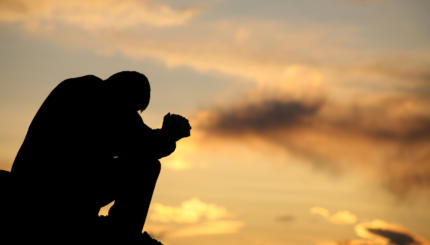Jews read sections of the
each week, and these sections, known as
parshiyot, inspire endless examination year after year. Each week we will bring you regular essays examining these portions from a queer perspective, drawn from the Torah Queeries online collection, which was inspired by the book Torah Queeries: Weekly Commentaries on the Hebrew Bible. This week, Jay Michaelson imagines how LGBT people can fulfill the commandment to love God with all of our hearts, souls, and might.
Creative Common/philippe leroyer
A tension: We are commanded, in
Parashat Vaetchanan
, to love God with all our heart, soul, and might – v’ahavta et adonai elohecha b’chol levavcha, b’chol nafshecha, u’vchol me’odecha. But what about everyone else? Do we love our families and God “in different ways”? At different times? Do we love other people as God, in a pantheistic sense – as incarnations of the One? And if so, what of their particularity?
Love itself may be simple, but its articulation is not.
And of course, for gays and lesbians, love is something that must, in a sense, be learned. Not the movement of love, of course – rather its articulation and its validity. Those of us who, for some period of time, denied our sexuality know that we need to love. The physical energies of sexuality may be dissipated in a variety of ways. But the spiritual and emotional energies of love must also find an outlet.
Perhaps, then, religion holds a perverse appeal: yes, it is the source of the repression, but it also offers an avenue to express the repressed. As the queer African-American poet Langston Hughes wrote:
To some people love is given
To others, only heaven.
Imagine a lifetime of romantic repression, and of alienation, and of the tight bond of secrecy linking the hidden homosexual with the One Who Knows all things. Is it any surprise that so many mystics, from Rumi to the Native American winkte, shared this bond of substituted passion?
And how many in our community feel it today? They may read these words only furtively, they may not identify publicly as gay – but from their yearning and loneliness nurtures a powerful shoot of love, even one that grows out of shadow. Most gay people, we suspect, leave religion and its ignorances. But some stay, and burn.
Clench your fist, and hold it for five seconds. The relaxation of release is more than what was there before the fist. In the same way, some of us have come to know love keenly because it has long been denied us.
But is the intensity of a Whitman or a Wilde only about repression? It their poetry reducible to a transmutation of the impossibility of the immanent into the fantasy of the transcendent?
By way of counter-example, consider the rapturous, homoerotic religious poetry of Sufi, Greek, and Japanese cultures, produced in climates without the repression and homophobia which we wrongly think to be universal. In these very different religious contexts, God was imagined as a beautiful boy by men, and as a maiden by women, and without the impetus of repression and sublimation. There, loving God was not a substitute for loving men or women.
So queer religiosity is not reducible to repression, or to a neurotic response to it, any more than is straight religiosity. We are sublimating only as much as others are.
And yet, there are some distinctive ways in which the V’ahavta is expressed by queer mystics around the world, ways that are directly traceable to the outsider experience of queers.
First, there are the distinct roles that have been assigned to queers in some religious cultures. In certain Native American traditions, for instance, when boys appear not to be taking an interest in girls, and appear to be taking on feminine traits, their inter-genderedness is acknowledged and sanctified by the community. Perhaps queers, like Jews, are a nation of priests. This explains the gender-variant shamans of the Plains Indians (including the Omaha, Sioux, Iban, and Hidatsa people) and Siberia (including the Chukchi, Yakut, and Koryak tribes), the basir of Borneo, the male isangoma of the Zulu. All apart from the conventions of love, in love with the Infinite instead.
Second, and conversely, there are the secular rituals of gay culture itself. Christian de la Huerta, author of Coming Out Spiritually, has suggested that what goes on in gay dance clubs on Saturday night is an ecstatic ritual, albeit with its spiritual heart removed. Dancing, celebration, trances, the use of drugs – all are hallmarks of ancient and deep ritual practices. But the sacred heart has been replaced with vapidity, because we have been so wounded by religion that we now cower from our sacred mission. Perhaps.
Third, queer religiosity often carries the perspective of the outsider, which lesbians and gay men share with prophets of all stripes. Like all outsiders, historically alienated queers have a perspective on society which insiders lack. They see that we live in boxes of our mental construction. And so they are more apt to transcend them. Hence the V’ahavta of the trickster: camp as coyote.
Fourth, the images are different. Imagining God as man and lover; resting in His arms; making love with my soul, or my body. My path cannot be the one of the majority, because its geography is defined by difference.
And finally, the V’ahavta of the gay man or lesbian is less innocent, more “experienced,” than that of the straight man or woman. This is the real meaning of the fairy tale about the prince disguised as a frog. In the original version of the tale, the frog does not turn into a prince when he is kissed. Rather, the lady who has found him ends up throwing him (in frog form) against the wall, in anger and frustration. Only then does he turn into a prince. Likewise for many of us, our anger at God is a step along the path to loving Her.
When I was younger, I was angry at God for making me gay. Still, sometimes, I feel it. Marriage is so beautiful, the alignment of love and society so neat. Same-sex marriage is also beautiful, but without the alignment, and with the slight ringing in the ears of bigoted slogans and jeers. There is an aspect of defiance, amid the harmony. Sometimes I want it to be pure.
Other times I was angry at God for allowing Himself to manifest in the form of misunderstandable verses of scripture. Or for not helping me be stronger in overcoming my urges. Or for not helping me be stronger in accepting and loving them.
I learned at least two things through this anger. I learned that, no matter how hard I tried to efface them, my desires were real. And I learned that, no matter how angry I was at God, how excluded I was from His service by those who interpret holy texts—no matter how many times I was rejected, that I still loved the Holy. I learned that love, too, was real.
So queer religious love, when it is realized, is necessarily self-aware, because it has been tested, as Abraham’s love was tested. The gay man, who has been required to know the holiness of his own love, has a different, and perhaps often deeper, understanding of what it is to love, than someone for whom love has always been sanctified. Our love is not taken for granted. It is not celebrated in most of our culture. It is something we come to know. And so we love God as we love people: with less innocence, but perhaps a more conscious affirmation. Even those of us who were never denied, must still return, again and again, to the source of our knowing – our love – when jabbed at by the fingers of bigots.
Would I have turned to meditation if I had not known twenty years of denial? Would I walk alone in the woods, seeking God, if I were fully satisfied with my personal life? I cannot say. There are those who claim that spirituality is only a balm, who wink at the curious coincidence that unloved souls are the ones who happen to perceive universal love emanating from every paper clip. But if we do that, if we reduce the love borne of suffering to a palliative, then we must also reduce every work of art to sensory titillation, and our joy at childbirth to gametes.


